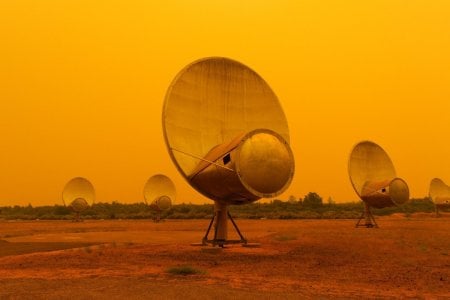Decode the Mystery: What Does the Bizarre Signal from 2023 Really Mean for Us? Discover Now!
- Replies 19
In the vast expanse of the cosmos, the possibility of encountering a message from an extraterrestrial source has long captivated the human imagination. The year 2023 brought us closer to this science fiction scenario when an art project by the SETI Institute simulated the reception of an alien-like signal. The project, titled 'A Sign in Space,' was an ambitious endeavor to explore the complexities involved in decoding a message from the stars. The simulation became a reality for a father-daughter duo of citizen scientists who managed to decipher the signal, but the true meaning behind the message remains an enigma wrapped in a cosmic riddle.
The signal, which originated from the ExoMars Trace Gas Orbiter, a European Space Agency spacecraft orbiting Mars, was a test of human ingenuity and collaboration. It traveled 16 minutes through space before being captured by three Earth-based observatories and subsequently released online for the public to analyze. This open invitation to crack the code attracted Ken Chaffin and his daughter Keli, who dedicated nearly a year to the task. Their journey through thousands of hours of mathematical simulations and experimentation is a testament to the power of curiosity and perseverance.
The decoded message, visualized as fleeting clusters of white pixels against a dark background, revealed five configurations representing amino acids—the fundamental building blocks of life. This fleeting image, lasting only a tenth of a second, suggests a dynamic and complex communication, far from the static messages we are accustomed to on Earth. The project's designers have confirmed that the amino acids are indeed the intended message, but they have left the interpretation to the global community of citizen scientists and enthusiasts.

The Chaffins' breakthrough in decoding the message was a significant milestone, but it is only the beginning of a larger quest to understand the intent behind such a transmission. Ken Chaffin's background in cellular automata, a form of mathematical modeling, was instrumental in unraveling the visual puzzle, which he initially suspected to be a 'starmap.' The revelation of amino acids in the message resonated with his knowledge of chemistry, sparking numerous hypotheses about the message's significance.
Keli Chaffin's involvement, initially unplanned, grew into a deep fascination with the project's scope and the potential implications of the message. The original image, which some likened to a Rorschach test, evoked various interpretations from the community, ranging from biological lifeforms to celestial maps. This diversity of perspectives highlights the subjective nature of interpreting such a message and the challenges we would face in reaching a consensus on its meaning.
The project's goal was to simulate the real-life scenario of receiving an extraterrestrial message without any guidance or feedback. Daniela de Paulis, the artist behind the project, emphasized the importance of independent interpretation, mirroring the likely reality of an actual encounter with an alien communication. The multitude of interpretations that emerged from the community underscores the complexity of this task.
Now that the message's content has been unlocked, the focus shifts to its purpose. Why would an alien civilization send a message composed of amino acids? What could it signify about the nature of life across the universe? Ken Chaffin's favorite interpretation is that of panspermia—the hypothesis that life is widespread in the cosmos and can be transported through space. The dynamic nature of the message could suggest the assembly of life's components, a cosmic dance of creation that transcends planetary boundaries.
As we ponder the implications of this simulated signal, we are reminded of the vastness of the universe and the potential for life beyond our own world. The 'A Sign in Space' project not only challenges us to decode a message but also invites us to reflect on our place in the cosmos and the universal language of life that may connect us with other beings.
 Members of the Seniors Discount Club, we invite you to share your thoughts on this intriguing cosmic puzzle. What do you think the message could mean? How do you imagine humanity would react to a real extraterrestrial communication? Join the conversation and let us explore the mysteries of the universe together.
Members of the Seniors Discount Club, we invite you to share your thoughts on this intriguing cosmic puzzle. What do you think the message could mean? How do you imagine humanity would react to a real extraterrestrial communication? Join the conversation and let us explore the mysteries of the universe together.
The signal, which originated from the ExoMars Trace Gas Orbiter, a European Space Agency spacecraft orbiting Mars, was a test of human ingenuity and collaboration. It traveled 16 minutes through space before being captured by three Earth-based observatories and subsequently released online for the public to analyze. This open invitation to crack the code attracted Ken Chaffin and his daughter Keli, who dedicated nearly a year to the task. Their journey through thousands of hours of mathematical simulations and experimentation is a testament to the power of curiosity and perseverance.
The decoded message, visualized as fleeting clusters of white pixels against a dark background, revealed five configurations representing amino acids—the fundamental building blocks of life. This fleeting image, lasting only a tenth of a second, suggests a dynamic and complex communication, far from the static messages we are accustomed to on Earth. The project's designers have confirmed that the amino acids are indeed the intended message, but they have left the interpretation to the global community of citizen scientists and enthusiasts.

A father-daughter duo of citizen scientists decoded a simulated alien signal sent from Mars as part of a SETI Institute art project. Credit: Facebook / SETI Institute
The Chaffins' breakthrough in decoding the message was a significant milestone, but it is only the beginning of a larger quest to understand the intent behind such a transmission. Ken Chaffin's background in cellular automata, a form of mathematical modeling, was instrumental in unraveling the visual puzzle, which he initially suspected to be a 'starmap.' The revelation of amino acids in the message resonated with his knowledge of chemistry, sparking numerous hypotheses about the message's significance.
Keli Chaffin's involvement, initially unplanned, grew into a deep fascination with the project's scope and the potential implications of the message. The original image, which some likened to a Rorschach test, evoked various interpretations from the community, ranging from biological lifeforms to celestial maps. This diversity of perspectives highlights the subjective nature of interpreting such a message and the challenges we would face in reaching a consensus on its meaning.
The project's goal was to simulate the real-life scenario of receiving an extraterrestrial message without any guidance or feedback. Daniela de Paulis, the artist behind the project, emphasized the importance of independent interpretation, mirroring the likely reality of an actual encounter with an alien communication. The multitude of interpretations that emerged from the community underscores the complexity of this task.
Now that the message's content has been unlocked, the focus shifts to its purpose. Why would an alien civilization send a message composed of amino acids? What could it signify about the nature of life across the universe? Ken Chaffin's favorite interpretation is that of panspermia—the hypothesis that life is widespread in the cosmos and can be transported through space. The dynamic nature of the message could suggest the assembly of life's components, a cosmic dance of creation that transcends planetary boundaries.
As we ponder the implications of this simulated signal, we are reminded of the vastness of the universe and the potential for life beyond our own world. The 'A Sign in Space' project not only challenges us to decode a message but also invites us to reflect on our place in the cosmos and the universal language of life that may connect us with other beings.
Key Takeaways
- A father-daughter team of citizen scientists deciphered a simulated alien-like signal sent from Mars as part of a SETI Institute art project.
- The signal contained visual representations of amino acids, but their deeper meaning remains undeciphered and open to interpretation.
- The project aimed to simulate the real-life process of receiving and interpreting an extraterrestrial message, without outside assistance.
- The team and the wider community continue to devise and discuss potential interpretations for the message, mirroring the complexities of understanding a real extraterrestrial communication.







